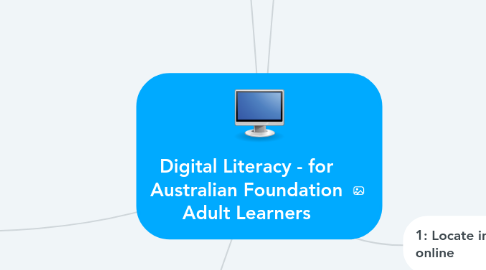
1. 4: Share information
1.1. Methods
1.1.1. Oral presentation
1.1.2. Written presentation
1.1.3. Visual presentation
1.2. Oral Skills
1.2.1. Level 1 (1.07)
1.2.1.1. Short and simple descriptions, summaries, statements, explanations and answers to questions
1.2.2. Level 2 (2.07)
1.2.2.1. Simple descriptions, summaries, statements, explanations, opinions and answers to questions
1.2.3. Level 3 (3.07)
1.2.3.1. Some detailed descriptions, summaries, statements, explanations, opinions and answers to questions
1.2.3.2. Ability to vary structure, style, tone and vocabulary to suit audience and purpose
2. 2: Store information
2.1. Print webpages
2.2. Write notes
2.3. Bookmark websites
2.4. Add to Favourites
2.5. Copy to usb
3. 3: Create new information
3.1. Formats
3.1.1. Powerpoint
3.1.1.1. Microsoft PowerPoint
3.1.1.2. Google Presentation
3.1.2. Spreadsheet
3.1.2.1. Microsoft Excel
3.1.2.2. Google Spreadsheets
3.1.3. Chart
3.1.3.1. Microsoft Word
3.1.3.2. Google Docs
3.1.4. Poster
3.1.4.1. Microsoft Word
3.1.4.2. Google Drawings
3.1.5. Written document
3.1.5.1. Microsoft Word
3.1.5.2. Google Docs
3.2. Writing Skills
3.2.1. Level 1 (ACSF 1.05 1.06)
3.2.1.1. Short texts with simple structure
3.2.1.2. Limited vocabulary
3.2.1.3. Basic grammar, punctuation, spelling
3.2.2. Level 2 (ACSF 2.05 2.06)
3.2.2.1. Simple texts and paragraphs
3.2.2.2. Some lists of information
3.2.2.3. Familiar vocabulary
3.2.2.4. Some action words and adjectives
3.2.2.5. Checking of punctuation and spelling
3.2.3. Level 3 (ACSF 3.05 3.06)
3.2.3.1. A range of text types and structures
3.2.3.2. Sequencing of ideas
3.2.3.3. Use of some specialised vocabulary
3.2.3.4. Some complex and compound sentences
3.2.3.5. Checking of grammar, punctuation & spelling
3.3. Numeracy Skills
3.3.1. Level 1 (ACSF 1.11)
3.3.1.1. Writes numbers in the 100s
3.3.1.2. Uses simple and informal symbolism
3.3.2. Level 2 (ACSF 2.11)
3.3.2.1. Uses informal and some formal symbolism, diagrams, graphs and conventions
3.3.3. Level 3 (ACSF 3.11)
3.3.3.1. Uses informal and formal mathematical language, symbolism, diagrams, graphs and conventions
4. 1: Locate information online
4.1. Knowledge
4.1.1. Keywords for searches
4.1.2. Website features / structures
4.1.3. Website jargon, terminology
4.2. Reading Skills
4.2.1. Navigation
4.2.1.1. Find main ideas
4.2.1.2. Skim and scan
4.2.1.3. Recognise structure / format / layout
4.2.1.4. Read menus / tabs / headings
4.2.2. Comprehension strategies
4.2.2.1. Link & match info and images
4.2.2.2. Identify key words
4.2.2.3. Find answers
4.2.2.4. Separate fact from opinion
4.2.2.5. Interpret info
4.2.2.6. Understand words, terms, abbreviations
4.2.3. Thinking skills
4.2.3.1. Critical thinking
4.2.3.2. Make informed decisions
4.2.3.3. Relate to prior knowledge
4.2.3.4. Compare & contrast with other resources
4.3. Website critique
4.3.1. Trustworthy
4.3.1.1. Credible author / organisation
4.3.2. Up to date
4.3.2.1. Recently written or updated
4.3.3. Understandable
4.3.3.1. Vocabulary and language
4.3.4. Relevant
4.3.4.1. Provides information needed to solve the problem or answer questions
4.4. Learning Skills (ACSF .02)
4.4.1. Locate, evaluate and organise information
4.4.2. Use prior knowledge & scaffolding
4.4.3. Learn with and from others
5. Stimulus
5.1. Present problem / dilemma
5.2. Brainstorm
5.2.1. Share prior knowledge
5.2.2. Share prior experiences
5.3. Next steps
5.3.1. Learning Skills (ACSF .01)
5.3.1.1. Goal setting
5.3.1.2. Awareness of strengths & weaknesses
5.3.1.3. Planning & organising
